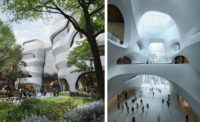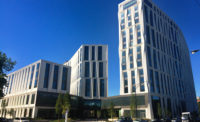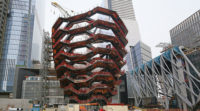A small gathering on June 3 in Downtown Brooklyn celebrated the topping out of 11 Hoyt, the latest addition to the neighborhood’s growing skyline. It is the first large-scale residential project in New York for both Studio Gang and the interior design team, Michaelis Boyd Associates–the project was designed in collaboration with Hill West Architects. Slated for completion at the end of 2020, the 57-story, 770,000-square-foot building will have 481 apartments and will be ringed by retail spaces at its base, occupying a whole city block.
The building’s facade is composed of white precast concrete panels, fabricated in Canada and trucked onto the site. Some of these, with their scalloped edges, push out to create a gentle rippling effect on the exterior; inside, this feature expands the living spaces with built-in bay window seats that will allow residents to inhabit the facade itself. At the topping out, Jeanne Gang explained that the design took its cues not only from the classic bay windows found on the rows of nearby brownstones, but also from the historic buildings’ materiality. “It has this minerality to it,” the architect said of the gleaming concrete.The architects say that the 140 variations of facade module grew from an initial 38, in order to produce varied apartment types that are “not just for one demographic.” Apartment buyers can choose from 190 different floor plans. “Having all these different types of units, but then trying to keep some modularity to the facade, was a big challenge,” Gang said. In the end, she says, she was elated that, as the project progressed, it started “looking just like the rendering.”
Views from the highest floors include the Manhattan skyline and the Verrazzano-Narrows Bridge connecting Brooklyn to Staten Island to the south. To the east, vistas stretch past Coney Island and out to the ocean. A motor court in front of the building will allow residents and guests to enter away from the busy street, and an elevated private park on the second floor will provide a small sanctuary for residents amidst the dense, urban surroundings. With this in mind, landscape architect, Hollander Design, included milkweed and thistle in the park to lure migratory monarch butterflies to the site as they make their annual passage through the city.





Post a comment to this article
Report Abusive Comment